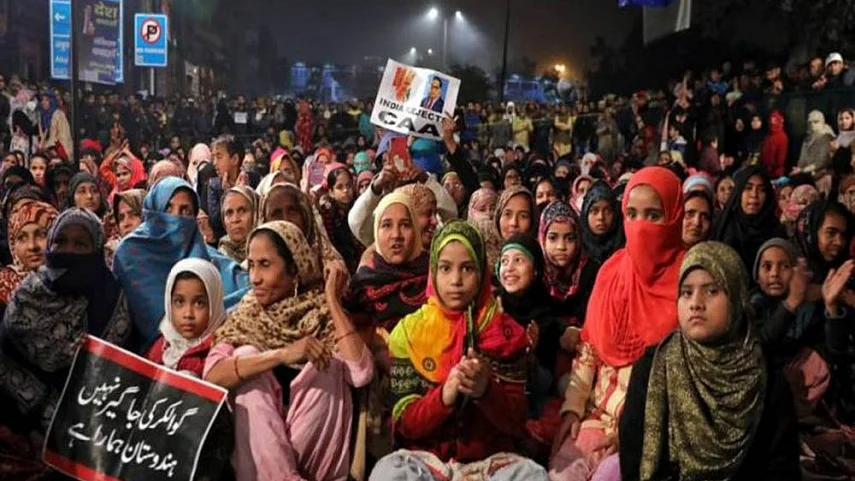Book Extract: The legend of Shaheen Bagh
Within a week, the Muslim women of Shaheen Bagh, some barely literate, had found their real calling. They became both the metaphor and the anchor for the anti-CAA protests in the rest of the country

As the Indian Parliament passed the Citizenship Amendment Bill, Tarannum Begum, a widow of many years, was making rotis for her children at home in Batla House. The news that was to change her life forever passed her by.
Three days later, on 15 December 2019, this life-changing news finally hit home. The Delhi police entered the Jamia Millia Islamia campus next to her house and brutalized the students. The police also entered the library, using tear gas shells to flush out the students; they then used batons to beat them.
Tarannum turned off the stove, wrapped a shawl around her shoulders, and stormed out of her house screaming, ‘Ab nahin toh kab?’ (if not now, then when?). Her neighbour, who too had heard the news of the assault, joined her. And then a few more women joined them.
‘I was very angry at the police for hitting our children,’ she recalls. ‘I wanted to protect our children. I wanted to hit back at the police. I wanted to scream. I wanted to tell the police to go away.’ Then catching her breath, she says, ‘I had no idea what I wanted to do.’
For some time, the group of screaming women moved down the road further inside the university campus without a sense of direction. Their only thought was to claim the space for the children. Then somebody mentioned the police barricade towards the southeastern end of the campus in the area called Shaheen Bagh.
The marching women found direction. ‘We went there. The police stopped us at the barricade, pushing us back. Some women fell back. I don’t know what came over me,’ says Tarannum. ‘I just sat down there on the road. Two other women also sat down with me. We refused to leave.
The women spent the night of 15 December under the sky in numbing cold, kick-starting what is now known as the Shaheen Bagh protest. ‘We didn’t feel the cold. Our rage was keeping us warm,’ says Tarannum.
By the next morning the word had spread. More women and men came to join them, in the spirit of Majrooh Sultanpuri’s couplet ‘Main akela hi chala tha janib-e-manzil magar/ log aate gaye, karwaan banta gaya’ (alone I started towards the destination, people joined me and we became a movement).
Neighbours and good Samaritans started pitching in to help the protesting ladies. Mattresses, quilts, braziers, and tents were arranged. Volunteers started contributing drinking water, food, and over-thecounter medicines to the women sitting on the road. As the numbers soared and facilities improved, several similar protests started to sprout around the country.
Within a week, the Muslim women of Shaheen Bagh, erstwhile homemakers, some barely literate, had found their real calling. They became both the metaphor and the anchor for the anti-Citizenship Amendment Act (CAA), anti-National Register of Citizens (NRC), and anti-National Population Register (NPR) protests in the rest of the country.
Conservative, veiled Muslim women had never been seen or heard on the streets before. At Shaheen Bagh, not only were they seen and heard, they were expressing sound political opinions with clarity. They were giving interviews to television channels without the least bit of self-consciousness. They were articulate and consistent in their assertions.
‘How did you learn about the CAA and NRC?’ I asked Tarannum. It was 12 January 2020. We were sitting inside the medical tent next to the Shaheen Bagh protest site, as a havan (a Hindu prayer ritual in which offerings are burnt in consecrated fire) was underway.
A woman doctor, who volunteered at the medical camp on weekends, rushed to answer my question. ‘They don’t have to understand everything. There are people like us who understand—’ Tarannum, her face framed by a headscarf and forehead smeared with a thick vermilion mark, raised her hand to interrupt. Though she did not utter a word, her expression told the doctor to shut up.
Then turning to me, she said firmly, ‘It is true that when I left my house on 15 December, I had only heard of CAA. I had no idea what it was or what it would mean for people like us. I was angered by the police action against young children. But I was also curious to know why the students were protesting.
What had brought them onto the streets?’ Another woman entered the medical tent—also wearing the headscarf and the vermilion mark on her forehead. Tarannum greeted her warmly. ‘She has been with me since the beginning,’ she said by way of introduction. ‘Do you understand what CAA–NRC is?’ she asked her, and said to me, ‘She is from Bihar.’
‘Even if I didn’t know what it was, the Home Minister has made sure that everyone knows what it is,’ said the woman from Bihar with a confident grin. ‘Amit Shah has explained everything clearly. I know.'
Follow us on: Facebook, Twitter, Google News, Instagram
Join our official telegram channel (@nationalherald) and stay updated with the latest headlines
